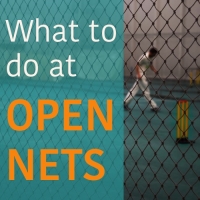What to do at Open Cricket Nets
 How do you train when the coach or captain says "do what you like, just get something meaningful done"?
How do you train when the coach or captain says "do what you like, just get something meaningful done"?
Modern coaches are all about giving players freedom to train. This means you need to be self-reliant as a player and work out your own training, even at group sessions. Yet often I see players given freedom and unsure what to do with it. They end up with a half-hearted warm up and getting a few throw downs under the guise of "getting my eye in".
We can do better than that.
So, the next time you have to direct your own training, if there is a coach there or not, here is what to do.
Have a goal that makes sense
Whatever your training, it's important to go into nets knowing what you want to get out of it. That means having a clear goal in mind so you can start working on it right away. If the training isn't meeting the goal, do something different.
One mistake I see a lot is the "ghost goal". This is when a player is unsure about a goal and so makes one up on the spot that is something like "I want to get my eye in" or "I'm trying to find rhythm". This sounds good but it doesn't mean much. No one can find rhythm or get their eye in during an indoor net 5 months out from the season.
So, set a goal that makes sense. In simple terms your goals can be,
- Technical. Making a change to some part of your technique or adding a new skill like a shot. This is best in the off season.
- Tactical. Working out how you play in certain scenarios and practicing that method until you can nail it. For example, yorkers at the death.
- Mental. Discovering how you react mentally to pressure and fatigue. Coming up with strategies to handle those moments
- Fitness. Building up your cricket stamina, speed, agility and power.
All these work best if you can measure how you are doing. I remember talking to a spinner who was doing target practice in his open session and he told me his issue was the first 18 balls of his spell. As soon as he got settled his bowling improved but it took him three overs to get into his stride. I advised that perhaps he should consider the first 18 balls every time he bowled in nets too. Note down what happens and track changes based on the outcome of those 18 balls. Laser focus.
Recruit your group
The first step to making an open net work is to recruit the people you need as quickly as possible. You have your goal, so get to work talking to people.
If there are coaches floating around, grab one and outline your target for the session. The coach might have told you to do your own thing, but they are also there to help you achieve that goal. You can get drill ideas, throw downs, someone to video you, or whatever you need to get going.
It's not just coaches either, chances are that there are players with goals that match yours that you can work with right away. If someone else wants to develop a sweep shot you can alternate throwdowns and advice. If a batsman wants to face the new ball and you are an opening bowler who wants to work on tactics in the first few overs you have a match made in heaven.
Again, measuring things is a powerful way to improve so chat for a moment about how you are going to measure the success of the session. In the new ball example above you can count how many times the batsman makes good contact vs. edging or playing and missing. This can be tracked over a number of weeks and even turned into a bat against ball competition where the winner buys the other dinner.
What you want to avoid is quietly letting other people achieve their goals with you getting nothing back in return. If the keeper asks you to give him some throws so he can do his drills, don't be afraid to tap him up for something in return. He will be happy to help.
Reflect on your session
Finally, when everything is done in nets it's important to reflect on the session rather than just skip away at the end waving over your shoulder and saying "see you next session guys!"
Ask yourself some questions, or sit down with your team mates and discuss it over a post-session beverage and food,
- What didn't we cover that we can cover next time?
- What did we do that didn't work and needs to be dropped?
- What things worked that we can continue next time, and how do we know they worked?
Keep it short and simple and walk away with some clear actions for the next session.
Open sessions are not an excuse to get out of fielding drills you hate and have a blast in nets instead. They are your opportunity to show how you can work towards your goals and reflect on your session well. If you can do those two things you will have made the most of the session.
- Login to post comments

